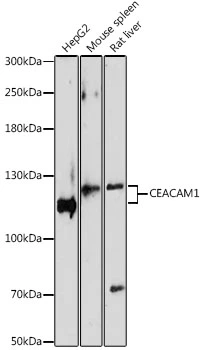
WB analysis of various sample lysates using GTX55568 CEACAM1 antibody. The signal was developed with ECL plus-Enhanced. Dilution : 1:1000 Loading : 25microg per lane
CEACAM1 antibody
GTX55568
ApplicationsWestern Blot
Product group Antibodies
TargetCEACAM1
Overview
- SupplierGeneTex
- Product NameCEACAM1 antibody
- Delivery Days Customer9
- Application Supplier NoteWB: 1:500 - 1:2000. *Optimal dilutions/concentrations should be determined by the researcher.Not tested in other applications.
- ApplicationsWestern Blot
- CertificationResearch Use Only
- ClonalityPolyclonal
- ConjugateUnconjugated
- Gene ID634
- Target nameCEACAM1
- Target descriptionCEA cell adhesion molecule 1
- Target synonymsBGP, BGP1, BGPI, cell adhesion molecule CEACAM1, CD66a antigen, antigen CD66, carcinoembryonic antigen related cell adhesion molecule 1, carcinoembryonic antigen-related cell adhesion molecule 1 (biliary glycoprotein)
- HostRabbit
- IsotypeIgG
- Protein IDP13688
- Protein NameCell adhesion molecule CEACAM1
- Scientific DescriptionThis gene encodes a member of the carcinoembryonic antigen (CEA) gene family, which belongs to the immunoglobulin superfamily. Two subgroups of the CEA family, the CEA cell adhesion molecules and the pregnancy-specific glycoproteins, are located within a 1.2 Mb cluster on the long arm of chromosome 19. Eleven pseudogenes of the CEA cell adhesion molecule subgroup are also found in the cluster. The encoded protein was originally described in bile ducts of liver as biliary glycoprotein. Subsequently, it was found to be a cell-cell adhesion molecule detected on leukocytes, epithelia, and endothelia. The encoded protein mediates cell adhesion via homophilic as well as heterophilic binding to other proteins of the subgroup. Multiple cellular activities have been attributed to the encoded protein, including roles in the differentiation and arrangement of tissue three-dimensional structure, angiogenesis, apoptosis, tumor suppression, metastasis, and the modulation of innate and adaptive immune responses. Multiple transcript variants encoding different isoforms have been reported, but the full-length nature of all variants has not been defined. [provided by RefSeq, May 2010]
- Storage Instruction-20°C or -80°C,2°C to 8°C
- UNSPSC12352203



